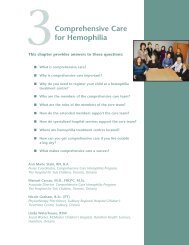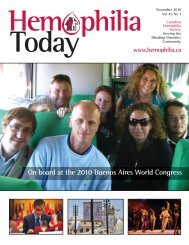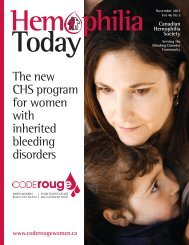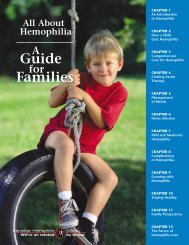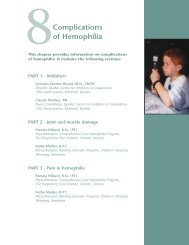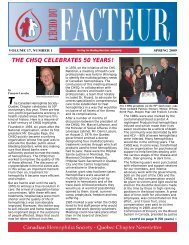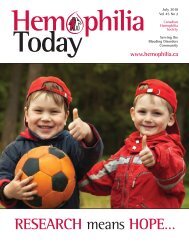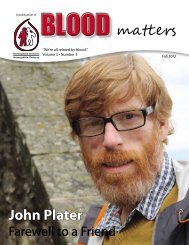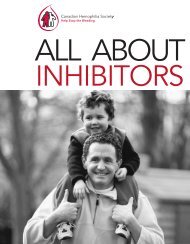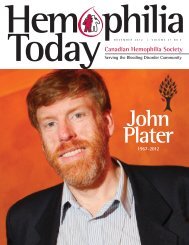10The Global PerspectiveHEMOPHILIA TODAY SUMMER 2002Eric Stolte,Chair, InternationalProjects CommitteeIn this issue, THE GLOBAL PERSPECTIVE presents reports,written by James Kreppner, Chair of the CHS Blood SafetyCommittee, and photographs from the XXV Congress ofthe World Federation of Hemophilia, held in Seville in May.THEGLOBALPERSPECTIVEXXV CONGRESS OF THE WFH, MAY 19-24, 2002, SEVILLE, SPAINBlood Product Issues at the ConferenceJames Kreppner, CHS Vice-President and Chair of the Blood Safety CommitteeThere were various presentations at the WFH Congress that concern blood product use. The four presentations I wouldlike to summarize include one on blood safety by Carol Kasper, two on blood safety and regulation by Albert Farrugia,along with another by William Velander on transgenic pigs and their potential as a cheap source of factor product.Multiple Levels of Viral SafetyCarol Kasper is a well known and respectedname in the hemophilia community. Herpurpose was to address the topic of bloodsafety and she mentioned that the world’sblood systems are moving to stricterstandards of safety. In particular, shementioned that a number of systems alreadytest minipools of plasma for viral nucleicacids (HIV and HCV). There is a moveunderway to add HBV, HAV and ParvovirusB19 as well. Many of these viruses are alsodetected via antibody tests. (An antibody testtells whether or not the immune system has agenerated a response to a particularinfectious agent, whereas the nucleic acid testlooks at whether any nucleic acid from theactual virus can be detected in the sample.)Nucleic acid testing is usually judged to besuperior as it often takes some time for thebody to generate an immune response (oftentermed the “window period”), and so anindividual may have infectious viruscirculating in his blood system which will bemissed by an antibody test.The second part of the process to ensuresafety is viral inactivation, and Dr. Kasperreferred to three methods that have someutility in eliminating viral contaminants. Shementioned slow heat treatment, solventdetergent treatment, and nanofiltration(especially for Factor IX which is a smallmolecule). Dr. Kasper stressed that it isimportant to have as many protectivemeasures as possible, as you may have adonation which contains a high level ofviremia. In that circumstance, you cannotcount on the viral inactivation process aloneto be effective to make the end product safe.Some have argued that the purification theproduct goes through in the productionprocess also lowers the risk of any viralcontamination, but she felt this to be only aminor contribution to safety.The final level of protection is surveillanceof recipients (she mentioned the Centers forDisease Control in the U.S.), and she pointedout that there has been no HIV transmittedsince 1987 in North America. The CDC starteda specific surveillance for Hepatitis C inhemophilia patients three years ago. Again,there have not been any “true seroconversions”from blood.The concluding comment was that bothrecombinant and plasma derived productsthat are provided by the majormanufacturers in the developed world arenow very safe and effective products. Dr.Kasper also made a comment regardingvCJD. She felt the dilution that took place inthe pooling process made this an unlikelythreat. In the question and answer sessionafter her talk, I queried her about this point,as this sounded quite similar to thearguments made in the past about HIV andhepatitis, namely that pooling would reducethe infectious element to such a low level thatit would not be infectious. This was provenPhotosThe participants inthis workshop,including MarionStolte, SaskatchewanRegional Coordinator,are discussing bettercommunications withmembers.More than 125 people from 71 countries attended the 3-daytraining session for WFH National Member Organizations inHuelva, Spain, held in conjunction with the XXV Congress.
HEMOPHILIA TODAY The Global PerspectiveSUMMER 200211not to be the case. In response, she pointedout that prions are different and they have avery low level of presence in blood to startwith, unlike HIV for example, which mayhave millions of viral particles per cubicmillimeter. I pointed out that little is knownabout the levels needed to effectivelytransmit vCJD (or other TSE infections), andespecially low levels may just meanexceptionally long incubation periods. (Onthe positive side, these longer time periodsmay perhaps be longer than average lifespans.)The Role of the RegulatorAlbert Farrugia is known for his dynamicviews on a range of issues, and he spokefrom his perspective as a regulator inAustralia. He pointed out that regulation isdominated by the U.S. Food and DrugAdministration (FDA) and by the EuropeanAgency for the Evaluation of MedicinalProducts, the EMEA. He stated that all otherregulators, including his own, are heavilyinfluenced by these two agencies. He saidthat regulators look at the safety, quality andefficacy of both the products and themanufacturing facilities. With respect tomanufacturing, they ensure that thefacilities are clean and that themanufacturing process follows GoodManufacturing Practices (GMPs). Ofcourse, they also look at the individualproducts for safety and efficacy. Dr. Farrugiapointed out that product safety is a multistepprocess. He stated, “We control verystrictly the quality of plasma forfractionation, and the importance of thiscannot be overemphasized. It is the firstpoint of quality control for ultimateproduct safety and it is extremely critical.”Like Dr. Kasper before him, he went on toemphasize that all levels of protection areneeded. It is not enough to say, “If you testthe plasma, that is enough,” or, “If youvirally inactivate, that is enough.”He then raised the interesting point thatsome viral inactivation processes maychange the nature of the product, andtalked about some cases in which the viralinactivation produced unusual inhibitors.Moreover, there are some studies that showthat the quality of the product can beaffected. One example was a solventdetergent treated plasma that causedunexpected reactions in patients undergoingliver transplants. He also showed data fromanother study that showed a differencebetween a product that was dry heat treatedcompared to a similar product that was wetheat treated. The point is that the regulatoralways has to closely monitor, because themore changes you make with respect toviral inactivation and the productionprocess, the more you may affect otherimportant aspects of the product.As a further example, he pointed outthat recombinant factor IX is not the exactlythe same as plasma derived factor IX, andthat you have to look closely at thesedifferences. He would term recombinantfactor IX to be a new drug, and he notedthat one of the differences was the differentrecovery in this product compared to itsplasma derived counterpart. (See Recoveryin Factor IX Concentrates on page 21 of thisissue of Hemophilia Today.) Subsequenttesting showed that there was less of therecombinant product present at a specifiedtime after the injection, than there wouldhave been if the product were plasmaderived, and this was especially true inchildren. He made it clear that he was notcriticizing recombinant factor IX, and hedid say that it was a good drug, but he wasjust illustrating the point that you cannotassume that one form of a factor product isnecessarily the same as another form offactor product.He concluded by stating that bloodproducts are amongst the most heavilyregulated products, and this is a reaction tothe mistakes of the past. These products arenow very safe. That being said, he felt thatregulators cannot relax their vigilance, andthey must always keep the benefit/risk ratioin mind, but the general public should haverealistic expectations of their regulators andthe inherent risks of biological products.Factor Products fromTransgenic PigsThe last speaker I will mention here is aresearcher from Virginia Tech, William H.Velander, Ph.D., who spoke about his workwith transgenic pigs. (You may have read aprevious article on this subject by Dr. PaulGiangrande in Haemophilia World, Vol. 8,No. 3, September 2001.) In essence, thisresearcher argued that pigs are the perfectbioreactors for factor products, and thatthey can be genetically engineered toproduce copious amounts of factor IX(and hopefully, in the future, factor VIII)in their milk. They are far more efficientthan the biomechanical bioreactors used toproduce current recombinant products. Hehas already produced some of these pigs.His presentation was really an update andit was optimistic in nature. An additionaltwist is that these pigs may be able toproduce such a tremendous amount offactor at such a small cost, that it may becost-effective to condense the factor intosome sort of pill. Studies have shown thatwhen individuals ingest factor productsTom Alloway, CHS President, representingCanada at the WFH General Assembly.Applause for acceptance of Jordan, Mexico, Palestine, SaudiArabia, Sri Lanka and Uzbekistan as new National MemberOrganizations of the WFH.



